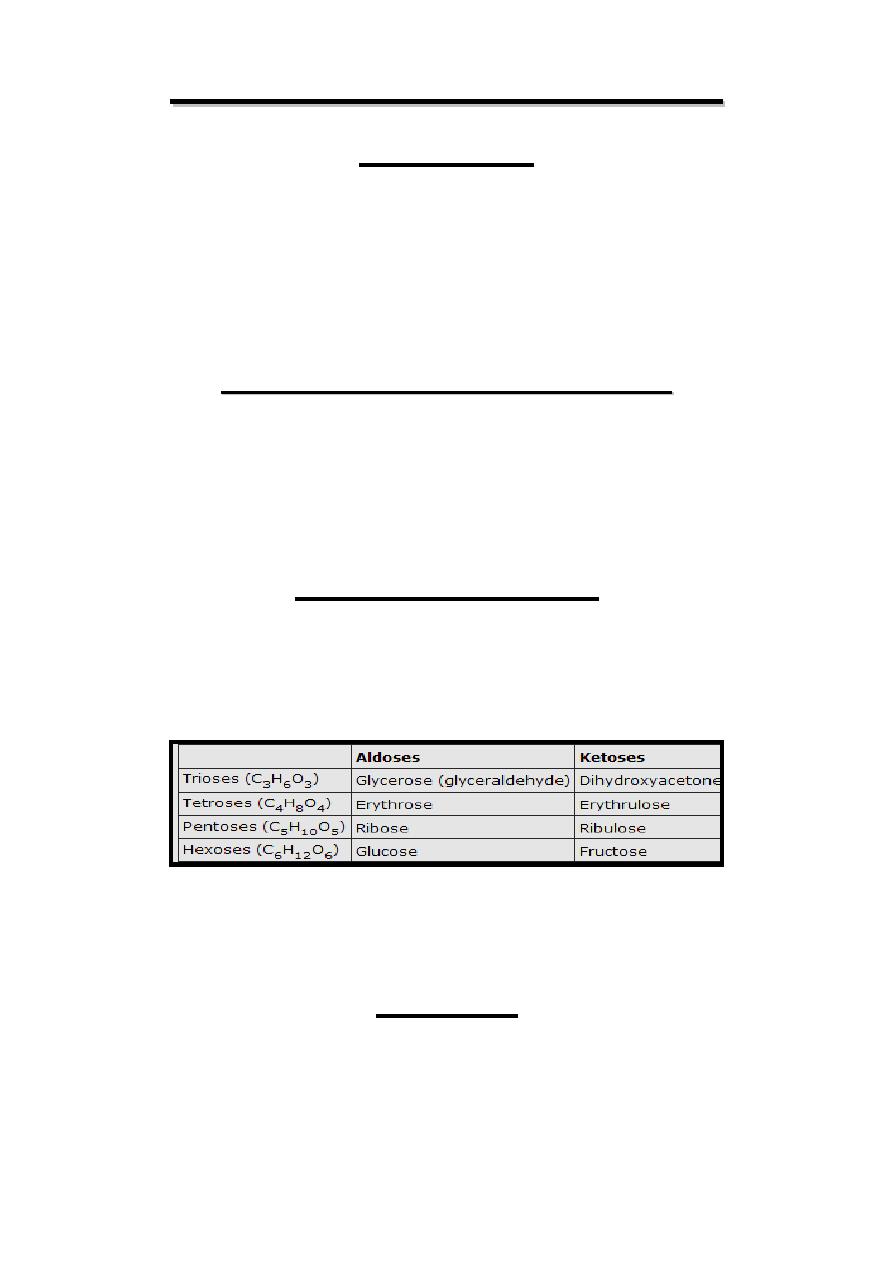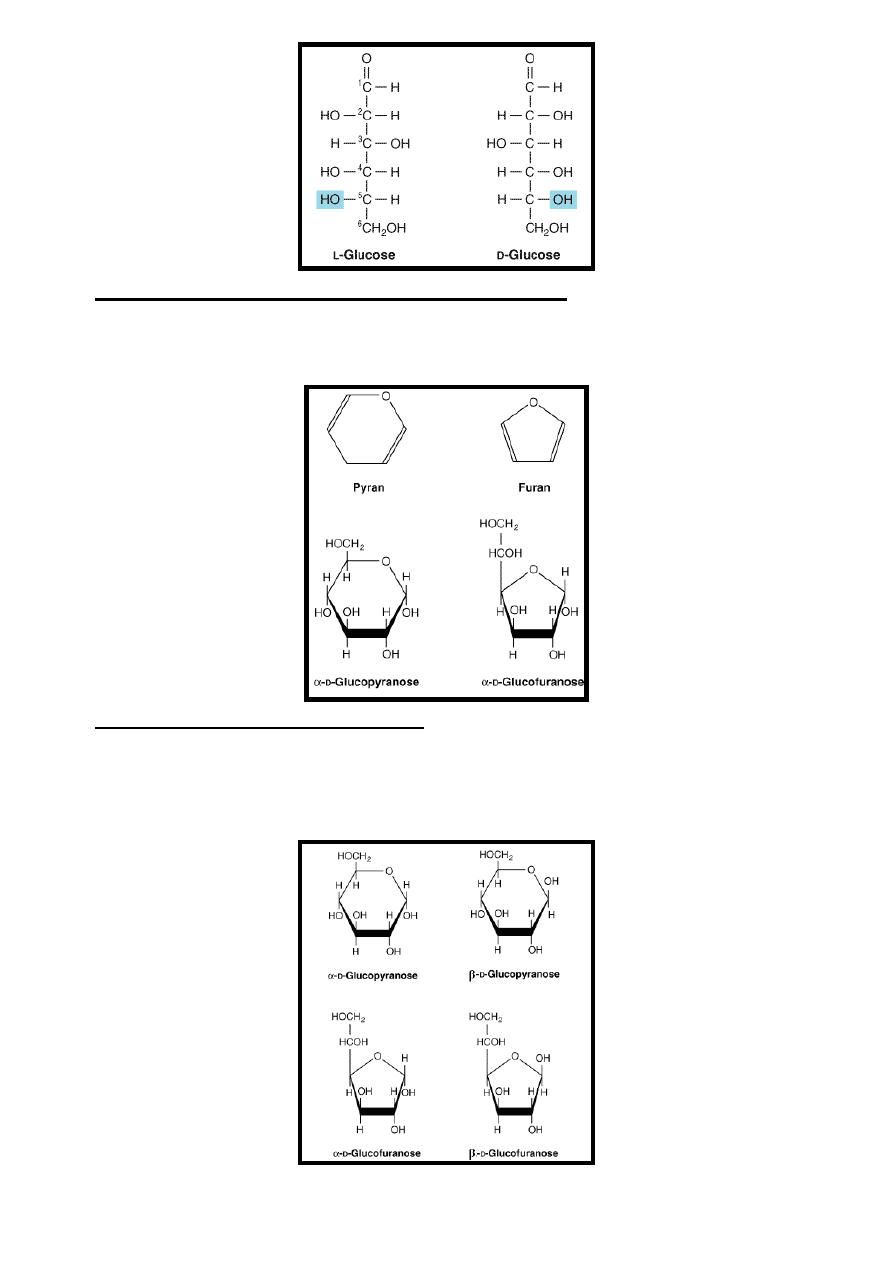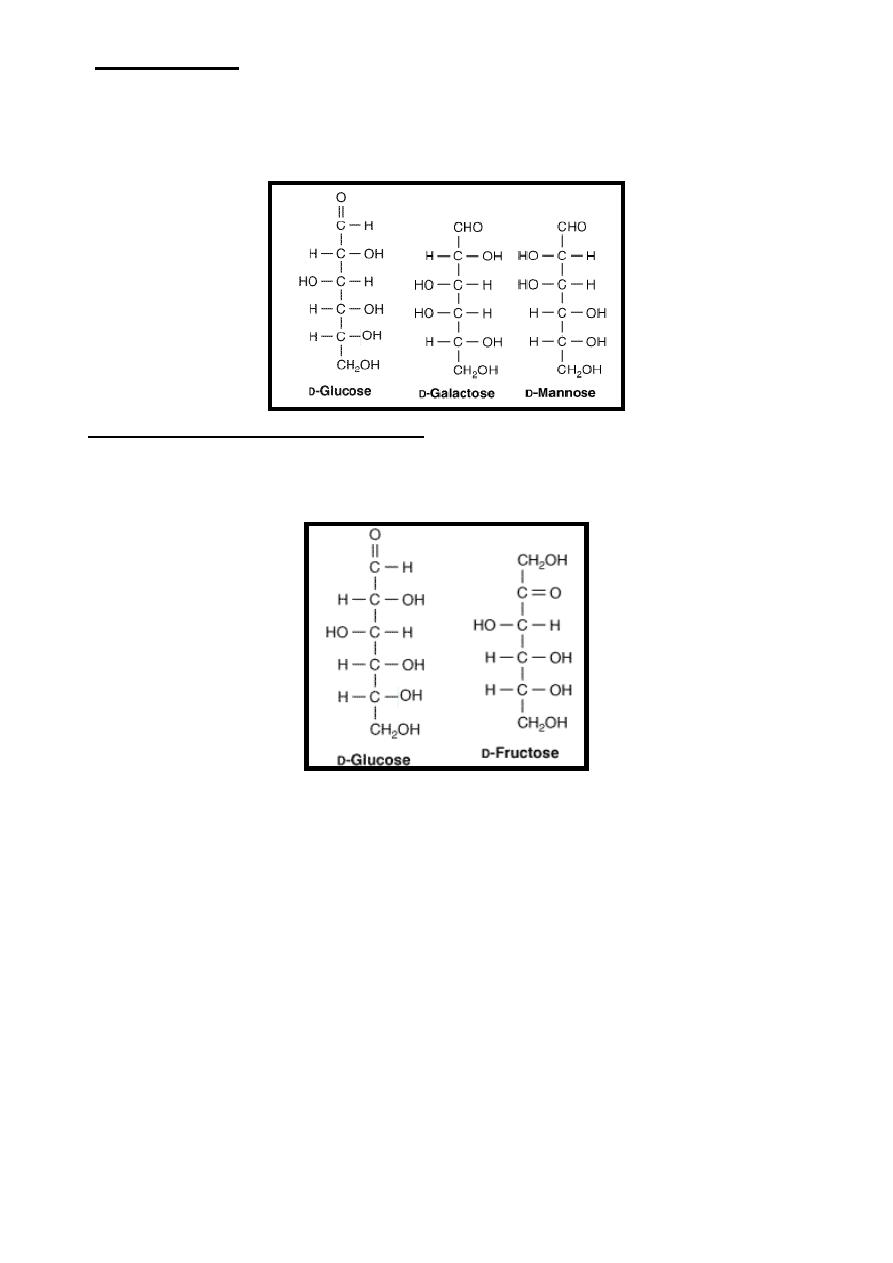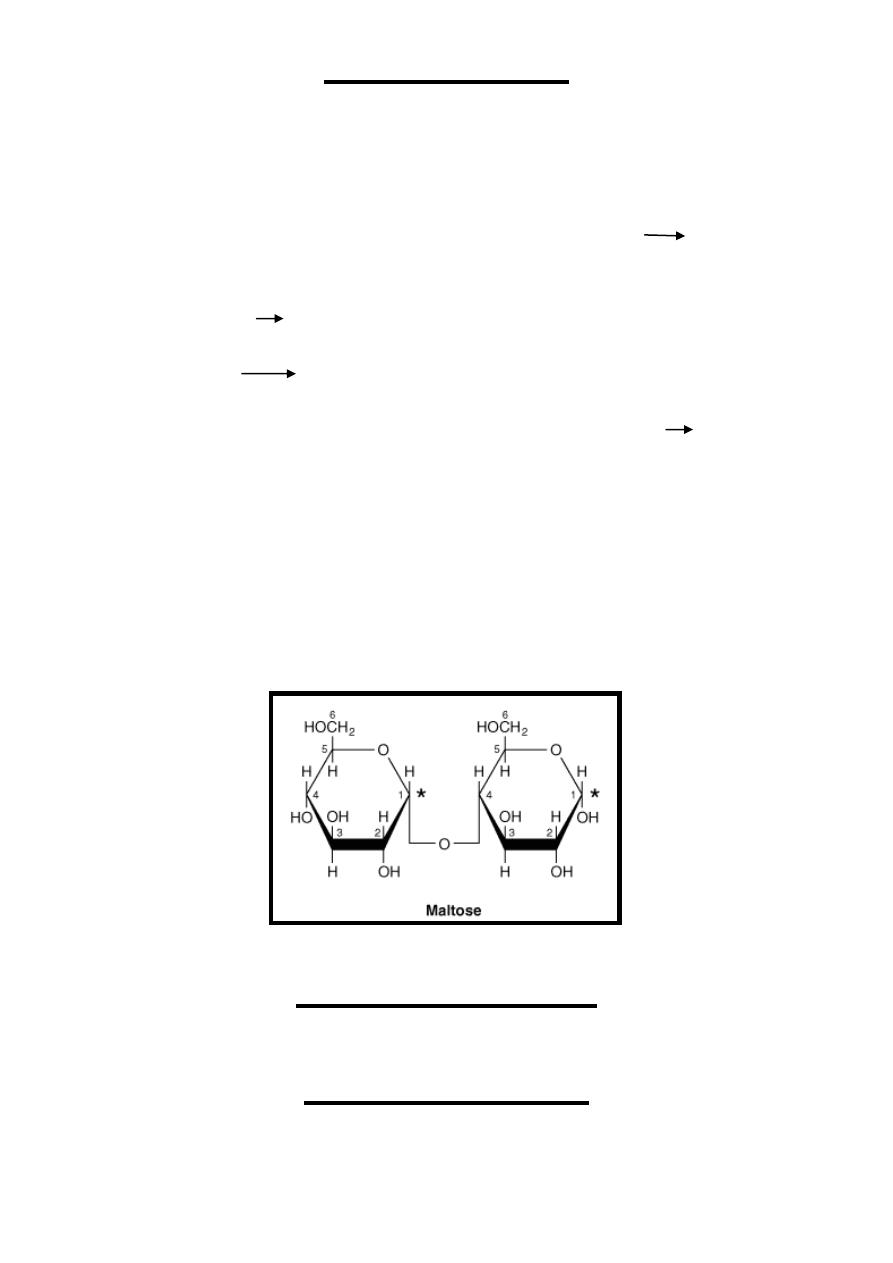
/كلية طب نينوى/ د بسام
55
-
56
5
C
C
a
a
r
r
b
b
o
o
h
h
y
y
d
d
r
r
a
a
t
t
e
e
s
s
(
(
C
C
H
H
O
O
)
)
Introduction
CHO are widely distributed in plants & animals.
In plants, glucose is synthesized by photosynthesis.
Animals can synthesize CHO from amino acids & other
compounds, however, most of animal CHO is derived from plants.
The main disease associated with CHO metabolism is diabetes
mellitus.
C
C
l
l
a
a
s
s
s
s
i
i
f
f
i
i
c
c
a
a
t
t
i
i
o
o
n
n
o
o
f
f
C
C
a
a
r
r
b
b
o
o
h
h
y
y
d
d
r
r
a
a
t
t
e
e
s
s
CHO are classified into:
(1) Monosaccharides.
(2)-Disaccharides.
(3) Oligosaccharides.
(4) Polysaccharides.
Monosaccharides
They are simple CHO (because can not be hydrolyzed to a
simplest form), it may contain 3, 4, 5, 6 or more carbon atoms
(known respectively as trioses, tetroses, pentoses, hexoses & so
on). It may be aldoses or ketoses depending whether they have an
aldehyde or ketone group respectively.
Most important monosaccharides are hexoses like glucose,
galactose & fructose which are reducing substances because it
contains aldehyde or ketone groups.
Glucose
Glucose is the most important monosaccharide because:
1)-
It’s major metabolic fuel in human specially CNS, fetus & RBC.
2)- Precursor for synthesis of all other CHO in the body.
3)-Other hexoses like fructose & galactose are converted inside the
body into glucose.

/كلية طب نينوى/ د بسام
55
-
56
2
Glucose Structure
The structure of glucose can be represented in three ways:
1- Straight-chain structural formula (aldohexose)
2-Cyclic structure: Formed by reaction between aldehyde group
& hydroxyl group.
3- Chair form: The cyclic structure is actually in the form of a chair.
Glucose Isomerism
The most important types of isomerism found with glucose are:
(1)- D & L isomerism: The orientation of
—H & —OH groups
around the carbon atom adjacent to the terminal carbon (carbon 5
in glucose) determines whether glucose (or other sugar) belongs to
the D or of its mirror image as the L form. When the
—OH group on
this carbon is on the right, its the D isomer & when on the left, its
the L isomer.
Most of the monosaccharides occurring in human including
glucose are D isomers.

/كلية طب نينوى/ د بسام
55
-
56
3
(
2) Pyranose & furanose ring structures: The ring structures of
monosaccharides are similar to the ring structures of either pyran
(a six-membered ring) or furan (a five-membered ring). For glucose
in solution, more than 99% is in the pyranose form.
(3) Alpha & beta anomers:
In solution the cyclic structure of
glucose is retained but isomerism occurs about position 1( carbonyl
or anomeric carbon atom)
to give a mixture of α-D-Glucopyranose
(38%) &
β-D-Glucopyranose (62%). Less than 0.3% is represented
by α & β anomers of D-Glucofuranose.

/كلية طب نينوى/ د بسام
55
-
56
4
(4) Epimers: The isomers differing as a result of variations in
configuration of the
—OH & —H on carbon atoms 2, 3 & 4 of
glucose are known as epimers. Biologically, the most important
epimers of glucose are mannose & galactose, formed by
epimerization at carbons 2 & 4 respectively.
(5) Aldose-ketose isomerism:
The main example of aldose-ketose
isomerism is fructose which has a potential keto group in position 2,
whereas there is a potential aldehyde group in position 1 of glucose
.
Examples of aldoses of physiological importance are:-
1-D-Glucose.
2-D-Glycerose (D-Glyceraldehyde)
3-D-Erythrose.
4-D-Xylose.
5-D-Arabinose.
6-D-Ribose.
7-D-Galactose.
8-D-Mannose.
Examples of ketoses of physiological importance are:-
1-Dihydroxyacetone.
2-D-Xylulose.
3-D-Ribulose.
4-D-Fructose.

/كلية طب نينوى/ د بسام
55
-
56
5
Disaccharides
They
are
products
of
chemical
reaction
between
2
monosaccharides with loss of a molecule of water (can be
hydrolyzed), the linkage between two monosaccharides is known as
glycosidic link.
The physiological important disaccharides are:
1-Maltose :- Link of two molecules of glucose by 1 4 glycosidic
link, produced by enzymatic hydrolysis of starch.
2-Lactose:- Link of one molecule of glucose with one molecule of
galactose by 1 4 glycosidic link , present in milk.
3-Sucrose:- Link of one molecule of glucose with one molecule of
fructose by 1 2 glycosidic link, present in cane & beet sugar
,some fruits & vegetables.
4-Isomaltose:- Link of two molecules of glucose by 1 6 glycosidic
link, produced by enzymatic hydrolysis of starch.
If the glycosidic link between aldehyde or ketone group of one
monosaccharide & the hydroxyl group of another monosaccharide
the produced disaccharide have reducing property(because contain
aldehyde or ketone group) as in maltose & lactose while if the
glycosidic link between aldehyde or ketone group of the two
molecules of monosaccharide the produced disaccharide have no
reducing property (because not contain aldehyde or ketone group)
as in sucrose.
Oligosaccharides
They are products of condensation of 3-10 monosaccharides as in
maltotriose.
Polysaccharides
They are products of condensation of more than 10 monosaccharide
units, they can be classified according to their origin or constituent:

/كلية طب نينوى/ د بسام
55
-
56
6
*Classification according to origin
I-Plant Origin: They include:-
A-Starch: Polysaccharide of plant origin (homopolymer of glucose
forming an
α-glucosidic chain, called glucosan or glucan) , it consist
of:
1-Amylose (one unbranched chain of glucose molecules linked by
α-1 4-glucosidic linkages with only terminal aldehyde is free).
2-Amylopectin :consists of branched chains composed of 24
–30
glucose residues united by α1 4 glucosidic linkages in the chains
& by α 1 6 linkages at the branch points .
B- Nonstarch polysaccharides: they include mainly:
1- Cellulose : It forms the major component of dietary fiber. they
are not digested by human enzymes b
ecause they linked by β 1 4
link because human intestine lack the enzyme that capable to
hydrolyze this link,
however, there is some bacterial metabolism of
cellulose in the human colon.
2-Inulin: Its a polysaccharide of fructose used to determine the
glomerular filtration rate, but its not hydrolyzed by intestinal
enzymes.
II-Animal Origin: Include mainly glycogen which is the storage
polysaccharide in animals including human & sometimes called
animal starch. It has structure similar to amylopectin except that
branching is more extensive.
*Classification according to constituent
Polysaccharides are sometimes classified as hexosans or
pentosans, depending on the identity of the constituent
monosaccharides.
Glycosides
Glycosides are formed by condensation between the hydroxyl
group of the anomeric carbon of a monosaccharide & a second
compound that may or may not be another monosaccharide.
Deoxy Sugars
Deoxy sugars are formed when one hydroxyl group is replaced by
hydrogen(lack oxygen atom),e.g. deoxyribose in DNA
.
Amino Sugars (Hexosamines)
They include mainly :
1- D-glucosamine.

/كلية طب نينوى/ د بسام
55
-
56
7
2-D-galactosamine.
3-D-mannosamine.
4-Several antibiotics (e.g., erythromycin) .
Glycosaminoglycans
(Mucopolysaccharides)
They are complex CHO containing amino sugars & uronic acids.
Glycoprotein (Mucoprotein)
Formed by conjugation of oligosaccharide with protein, if CHO
constitute 5-15% it's called glycoprotein while if CHO constitute 15-
75% it's called mucoprotein. They present mainly in cell
membranes.
Digestion & Absorption of Carbohydrates
Carbohydrates account for a large proportion of daily intake.
The main dietary digestible carbohydrates are:
1-starch (60-70%)
2- Sucrose (20-30%)
3-lactose (5%)
Absorption of carbohydrates from small intestine occurs only after
conversion of dietary carbohydrates into monosaccharide by the
following:
1-
α-amylase: Present in the mouth (salivary α-amylase) & in the
small intestine (pancreatic
α-amylase) split α-1,4-glucosidic links of
starch converting it into maltose, & isomaltose.
2-Small intestine: In the brush border of small intestinal mucosa,
the last stage of digestion occur where monosaccharides produced
to be ready for absorption, this occur by the following enzymes:
1-Maltase
—hydrolyzes maltose into two glucose molecules.
2-Sucrase
—hydrolyzes sucrose into glucose + fructose.
3-Lactase
—hydrolyzes lactose into glucose + galactose.
4-Isomaltase
—hydrolyze 1, 6 links of isomaltose.
The end products of carbohydrates digestion (monosaccharides)
are absorbed by small intestinal cells into the liver through the
portal vein.
The main dietary indigestible carbohydrate is cellulose which contain
β-glucosidic links due to lack of β-amylase enzyme in human.
